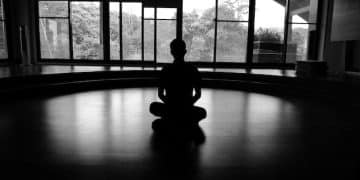Zen Meditation: A Beginner’s Guide to Finding Inner Peace

Zen meditation is a simple practice that can help anyone find their inner peace, reduce stress, and enhance mental clarity by focusing on the present moment and cultivating a non-judgmental awareness of thoughts and feelings.
Are you seeking a path to tranquility amidst the chaos of modern life? Discover Your Inner Peace: A Beginner’s Guide to Zen Meditation offers a simple, accessible introduction to this powerful practice.
What is Zen Meditation? A Gentle Introduction
Zen meditation, or Zazen, is more than just sitting quietly. It’s a direct path to understanding yourself and the nature of reality. Rooted in Buddhist tradition, it focuses on cultivating mindfulness and presence.
This practice involves sitting still, observing your thoughts and emotions without judgment, and connecting with the present moment. Let’s delve deeper into the core principles.
The Core Principles of Zen
At its heart, Zen meditation emphasizes simplicity and direct experience with no need for complex rituals or beliefs. The following principles are key.
- Mindfulness: Paying attention to the present moment without getting carried away by thoughts or emotions.
- Non-Judgment: Observing your thoughts and feelings without labeling them as good or bad.
- Presence: Fully engaging with the here and now, rather than dwelling on the past or worrying about the future.
- Acceptance: Acknowledging what is, just as it is, without resistance.
Zen meditation is about cultivating these qualities to develop a deeper sense of peace and clarity.

Setting Up Your Zen Meditation Space
Creating a dedicated space can enhance your meditation practice. It doesn’t need to be elaborate, just a quiet corner where you can sit comfortably and undisturbed.
Consider these elements to create a supportive environment.
Finding The Right Spot
Choose a place where you feel safe and comfortable. Minimize distractions and ensure you won’t be interrupted.
Essential Elements of Your Space
You don’t need much, but these additions can create the right atmosphere.
- Cushion or Bench: A comfortable place to sit is essential for longer sessions.
- Minimal Décor: Keep the space uncluttered to reduce distractions. Simplicity is key.
- Natural Light: If possible, choose a spot with natural light to create a calming ambiance.
- Quiet Ambiance: Minimize noise and distractions to help you focus on your inner self.
Remember, your meditation space is a sanctuary for your mind. Make it a place you look forward to spending time in.
Mastering the Practice: Essential Techniques for Zen Meditation
Zen meditation involves specific techniques to help you focus and stay present. These techniques are simple to learn, but require consistent practice.
Let’s explore some fundamental techniques to guide your journey.
Mindful Breathing
Breathing is always with you, making it a powerful anchor for presence. Focus on the sensation of each breath as it enters and leaves your body.
Posture and Body Awareness
Your posture plays a vital role in your meditation practice. Sit upright but relaxed, with your spine straight and shoulders loose.
Dealing with Distractions
Distractions are a natural part of meditation. Instead of fighting them, acknowledge them and gently redirect your focus back to your breath.
Zen meditation is a journey, not a destination. Be patient with yourself and trust the process.
Overcoming Common Challenges in Zen Meditation
Like anything new, Zen meditation can present challenges. Many beginners struggle with restlessness, wandering thoughts, and physical discomfort.
Here are strategies for overcoming these common obstacles.
Restlessness and Fidgeting
If you find yourself constantly fidgeting, try focusing on the physical sensations of your body. Notice the points of contact between your body and the cushion or the floor.
The Wandering Mind
It’s normal for your mind to wander. When you notice your thoughts drifting, gently guide your attention back to your breath without judgment.
Physical Discomfort
If you experience pain or discomfort, adjust your posture. You can also try meditating in a chair instead of sitting on the floor.

Integrating Zen Meditation into Daily Life
The benefits of Zen meditation extend far beyond the meditation cushion. Integrating mindfulness into your daily routine can transform how you experience life.
Consider these ways to bring Zen into your everyday activities.
- Mindful Eating: Pay attention to the taste, texture, and aroma of your food. Eat slowly and savor each bite.
- Mindful Walking: Notice the sensation of your feet touching the ground. Feel the air on your skin and the movement of your body.
- Mindful Communication: Listen attentively to others without interrupting. Speak with intention and kindness.
By practicing mindfulness throughout your day, you’ll cultivate a deeper sense of presence and appreciation for the simple things.
Zen Meditation and Mental Well-being
Zen meditation has been shown to have numerous benefits for mental well-being. Regular practice can reduce stress, anxiety, and depression, while enhancing focus and emotional regulation.
Let’s examine how Zen meditation supports mental health.
Reducing Stress and Anxiety
By cultivating mindfulness and acceptance, Zen meditation helps you respond to stress with greater equanimity. It can lower cortisol levels and promote relaxation.
Improving Focus and Concentration
Zen meditation trains your mind to focus on the present moment, which can improve attention span and cognitive function.
Enhancing Emotional Regulation
By observing your emotions without judgment, Zen meditation helps you develop greater emotional awareness and resilience. You learn to respond to emotions rather than react to them.
Zen meditation empowers you to cultivate a more peaceful and balanced life.
| Key Point | Brief Description |
|---|---|
| 🧘♀️ Mindfulness | Focus on the present without judgment. |
| 🌬️ Breath Awareness | Use breath as an anchor to the present. |
| 😌 Non-Judgment | Observe thoughts without labeling them. |
| 🧘♂️ Consistent Practice | Regular practice enhances benefits. |
Frequently Asked Questions about Zen Meditation
▼
The best time for meditation varies for each person. Many find morning sessions helpful for setting a calm tone for the day, while others prefer evenings to unwind before sleep.
▼
Begin with shorter sessions, such as 5-10 minutes, and gradually increase the duration as you become more comfortable. Consistency is more important than duration at first.
▼
While traditional postures like the lotus position are common, it is more important to be comfortable and maintain an upright spine. A chair is perfectly acceptable.
▼
It’s normal for the mind to be busy. Gently acknowledge the thoughts without judgment and redirect your focus to your breath. The goal is not to stop thinking, but to change your relationship with your thoughts.
▼
For most people, Zen meditation is safe and beneficial. However, individuals with certain mental health conditions should consult a healthcare professional before starting, as it can bring underlying issues to the surface.
Conclusion
Discover Your Inner Peace: A Beginner’s Guide to Zen Meditation is more than just a set of techniques; it’s an invitation to transform your relationship with yourself and the world. Start slowly, be patient, and trust the process. Your journey to inner peace begins with a single breath.





